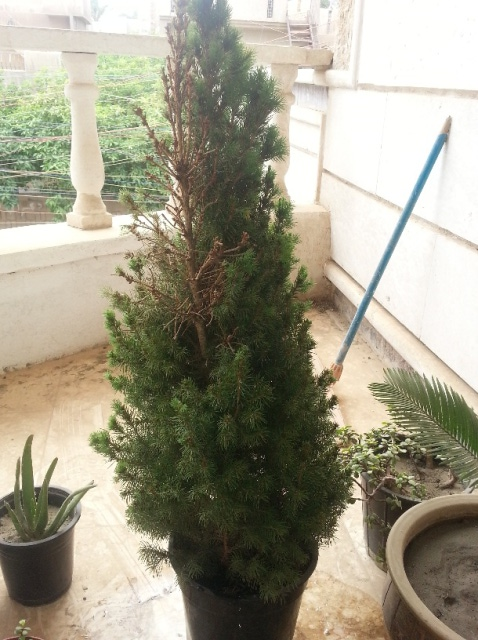Question
 pine tree
pine tree
Hi James
I have a pine tree in a pot I put it in my south facing balcony
It has been neglected little
I water it once every week or sometimes every 4 days
I just water it I am not even look at it's needles in the other side of it ( I mean the part that not facing me when I water it )
today I turned it and I see brown needles at the upper side of it and this browning is from only the side that facing sun I hope that I make you understand me .sorry for bad English
The brown needles is very brittle all the tiny brown hairs of needles fall off when I touch it. I water it now after I see this problem . do you think this is under-watering sign?I didn't water it for a week
The weather here is about 23 c at night to 30 c at afternoon
should I prune these needles? and how to water it correctly ?
should I re-pot it ?and move it to more sunny place?
please give me your advice I love this tree so much
thank you"
AnswerHello Sara,
Thank you for the question and for the picture of the tree. In climates such as Iraq this species has a tough time dealing with the persistent lack of moisture. Picea glauca is found naturally in the northernmost area of North America reaching up to the Arctic Circle. Although these trees are very versatile and can survive harsh conditions, the conditions in Iraq are likely pushing it to its limits. The damage you're seeing on your Picea glauca 'Dwarf Alberta' or dwarf Alberta spruce is something I've become very familiar with over the years. These trees are commonly grown in containers throughout the world to provide patios and porches with a little greenery.
Watering:
Remember that any tree grown in a container must be continually monitored for moisture and should only be allowed to dry completely for a short time. The pot should be allowed to dry between watering抯, but not to the point where needles begin to brown and fall off. On days where it is particularly hot (above 30 C) and it抯 windy, the tree should be checked daily to ensure it抯 not dried out. Prolonged dryness will cause entire branches to shed needles and die.
Mites:
In addition to monitoring the water you should be aware of other factors that will hurt your tree. The first that comes to mind is mites. Many species of mites attack Picea glauca and the damage they cause can be very destructive. An easy way to test if your tree has mites is as follows:
1. Use a white sheet of paper and place it on a book.
2. Tap the needles of the spruce tree over the white sheet of paper.
3. Slide your hand over the paper firmly. If you see red streaks where your hand touched,
then you have mites.
If mites are detected you抣l need to treat for them with a pesticide labeled for the treatment of mites. Since you抮e in Iraq I can抰 begin to offer you any direction as to where you抣l be able to obtain miticides. If you can抰 find a suitable miticide anywhere you can make your own miticide using this recipe:
1. Place 7.5 grams of liquid dishwashing soap into 1 liter of water.
(Do not use soap containing Alcohol)
2. Place mixture into a clean spray bottle.
3. Spray soap mixture on the spruce.
If possible, consider placing this tree in a more shaded area with a northern exposure. Cooler temperatures can reduce the instance of mites and also water stress.
Pruning:
I would wait for a few weeks before you prune any branches that may appear dead. Sometimes needles can regrow after being defoliated either by mites or water stress.
I hope I addressed all your concerns. If you have any additional issues let me know.
James






